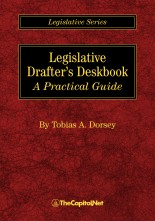When drafting federal legislation, it is important to ensure you are using the correct style. Style refers to the look and feel of a measure. While it might be assumed that style refers to the words that are used, style actually refers to the way in which words are placed on the page, a combination of elements used in a particular style.

The purpose of a style in legislative drafting is to ensure the text is easy to read and use. Today Congress tends to produce bills that are quite complex and large. While different drafter’s have their own style, consistency ensures that readers are not distracted by the style.
The same style has been used for all freestanding measures since the 1980s–the modified revenue style. This style is based on the revenue style, sometimes known as the tax style, which was developed as a result of the increasing complexity of income tax laws. The goal of the revenue style was to break complicated tax codes down into pieces that were smaller and more orderly.
 Section headings were made mandatory with the revenue style. The section heading in revenue style is required to be printed in all capital letters. The section heading must be prefixed to the section designation and number and end with a period. For example; SEC. 2. The section designation is always spelled out in the first section of the bill.
Section headings were made mandatory with the revenue style. The section heading in revenue style is required to be printed in all capital letters. The section heading must be prefixed to the section designation and number and end with a period. For example; SEC. 2. The section designation is always spelled out in the first section of the bill.
Headings are also mandatory for every subdivision, with the exception of subdivisions in which there is a dash list or colon list.
The revenue style was considered to be too rigid by many drafters, which led to the development of the modified revenue style. In particular, many considered the mandatory inclusion of subdivision headings to be a hindrance. Basically, the modified revenue style is the revenue style with more flexibility. Headings are still mandatory for use in subsections, but they are optional for subdivisions in the modified revenue style.
Modified revenue style is the default style for use in modern drafting, particularly for bills and joint resolutions. The traditional style is sometimes used for drafting concurrent resolutions and simple resolutions.
To learn more about effective legislative drafting, consider our Legislative Drafting Workshop.
Reference: Legislative Drafter’s Deskbook, by Tobias Dorsey, Chapter 8 Using the Right Style
For more than 40 years, TheCapitol.Net and its predecessor, Congressional Quarterly Executive Conferences, have been teaching professionals from government, military, business, and NGOs about the dynamics and operations of the legislative and executive branches and how to work with them.
Our custom on-site and online training, publications, and audio courses include congressional operations, legislative and budget process, communication and advocacy, media and public relations, testifying before Congress, research skills, legislative drafting, critical thinking and writing, and more.
TheCapitol.Net is on the GSA Schedule, MAS, for custom on-site and online training. GSA Contract GS02F0192X
TheCapitol.Net is now owned by the Sunwater Institute.
Teaching how Washington and Congress work ™

